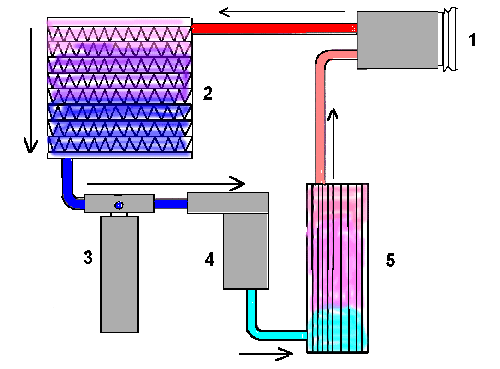Basic Porsche Air Conditioning System Operation

The basic Porsche AC System- air conditioning circuit has a “high” and “low” side. The high side starts at the compressor outlet and continues through the condenser, receiver dryer (drier) and ends at the outlet of the expansion valve. The “low” side starts at the outlet of the expansion valve, continues through the evaporator and ends at the inlet to the compressor.
The three basic states of matter are: solid, liquid and gas. When the refrigerant gas is compressed its pressure rises. As the pressure rises so does the temperature of the gas molecules. Hotter molecules have a tendency to travel toward cooler molecules. This is the basic concept that makes your air conditioning system work and your engine’s cooling system works on the same principle: hot molecules move toward cooler molecules.
There are two types of a/c systems found in automobiles:
- “Expansion” valve systems, which use a Thermal Expansion Valve and a “Drier”
- The Orifice Tube system, which uses a orifice tube and a “Accumulator”
Expansion valve systems are commonly used today. The information in these pages is directed toward those systems.
Expansion Valve Systems
- The Compressor pulls (pumps) refrigerant in a gaseous state from the low side of the circuit. As gas moves through the compressor pump it rises in pressure and temperature as it’s compressed.
- The hot high pressure gas enters the top of the Condenser. This “heat laden” gas travels downward through the condenser. The gas’s hot molecules are attracted to the cooler surfaces of the condenser. As the vehicle moves down the road, or the engine or condenser fan moves air through the condenser, the heated air molecules on the condenser’s outer surface move toward (exchange) the cooler air molecules moving over the surfaces, hence the condenser is called a “heat exchanger”. By the time the gas reaches the bottom of the condenser it loses enough heat to change its state from a gas to a liquid.
- The liquid refrigerant enters the receiver dryer (drier) where it is stored until some point when the expansion valve opens. While the refrigerant passes through the drier a drying material called a “desiccant” absorbs water moisture and contamination from the refrigerant. As a footnote you may have heard of the term “liquid side” of the system. The liquid side we say starts when the refrigerant leaves the condenser and continues up to the evaporator.
- When the expansion valve “asks” for liquid refrigerant, the liquid passes through the expansion valve inlet and is metered and atomized (misted) which causes a pressure drop on the outlet side of the valve. By the way there are basically two methods of atomizing the refrigerant: the first we mentioned is with an “expansion valve”, the second is with an “orifice tube”; either type works, it’s just a matter of system design. TIP: One of the signs of a “normally” functioning system is that the inlet a/c line entering the expansion valve will usually be very warm to hot as compared to the outlet tube coming out of the evaporator. The outlet tube of the evaporator should be cool to cold and may be sweating. If you notice the “inlet” side of the expansion valve is sweating or frosted then you probably have a defective valve or blockage.
- The atomized refrigerant, now at a lower pressure, enters the Evaporator. Since the refrigerant is at a lower pressure it also contains less heat. The evaporator’s fan moves warm air molecules across the evaporators outer surface. The outer warm molecules are exchanged with the inner cooler molecules (the evaporator is simply another heat exchanger like the condenser). As the outer warm air molecules contact the evaporator surfaces moisture from the vehicles interior condenses on the surface thus removing humidity from the air for additional comfort. The cool dry air is transferred through the air vents to the inside of vehicle. By the time the refrigerant exits the evaporator it’s state changes from an cool atomized liquid to a warm gas. And, the cycle of refrigerant through the air conditioning circuit is repeated.